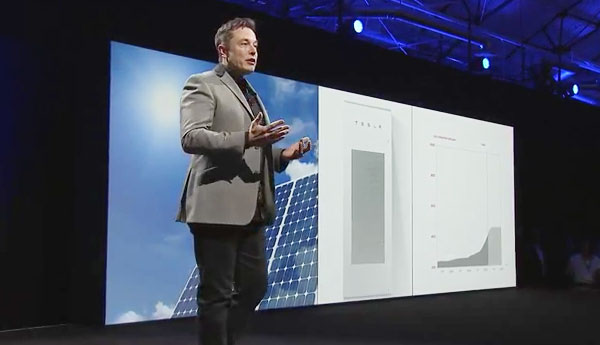Tesla Motors CEO Elon Musk on Thursday announced the company’s plan to develop residential and business battery systems, including the Powerwall Home Battery and business-oriented Powerpack.
These systems are being developed to work in conjunction with solar panels to store energy for use at a later time. They also can draw power from the grid when the demand for electricity is low and discharge it during the more expensive rate periods when demand is higher.
Musk, who demonstrated the technology to a crowd at Tesla’s design center outside Los Angeles, suggested it could substantially reduce energy dependence on fossil fuels and benefit people who live off the grid.
The Powerwall will be available as a 10kWh system that is optimized for backup applications, as well as a 7kWh solution for daily applications. Both can be connected to solar panels or to the grid, and both can provide backup power.
When paired with the solar power options, the 7kWh Powerwall can be used in daily cycling to extend the environmental and cost benefits of solar into the evening hours.
These rechargeable lithium-ion battery packs, which can be mounted to a home garage wall, can provide power when there is a fluctuation in the electrical grid.
The Powerwall, which was derived from the battery technology inside the Model S electric cars developed by Tesla Motors, will be available later this year for around US$3,500. Up to nine battery packs can be connected together to provide greater storage capacity.
Tesla already has announced several partnerships in a number of categories, including SolarEdge and Green Mountain Power in residential/small commercial; Target, Amazon, and EnerNOC in large commercial; and AdvancedMicrogrid Solutions, Southern California Edison/SoCore Energy and AES in utility-scale.
Bright Idea
The batteries’ benefits are three-fold: They can provide load shifting of charging during low-rate periods, store surplus solar power, and provide backup power in the event of an outage. This combination of selling points could be an advantage over other systems that address only limited problems or provide limited benefits.
“Utility costs are going up, so we are at the beginning of a response stage where there are smart meters that charge more for peak usage, so this could provide some relief when there is peak demand,” said VishalSapru, energy, and environment research manager at Frost & Sullivan.
“During off-peak times, consumers could go back to the grid,” he told TechNewsWorld.
“It could also be a benefit in regions where there are power outages and could provide that backup power,” Sapru added. “It could be a light at the end of the tunnel for residents that face regular storms or extreme winters that impact the grid.”
Costs vs. Benefits
The upfront cost of the batteries could prove to be a game changer.
“The price points of the two Powerwall options for residential and small commercial segments will surely give minor jolts to the industry,” said Ravi Manghani, senior energy storage analyst at GTM Research.
“Price tags of $3,000 for 7kWh — daily cycling application — and$3,500 for 10kWh — backup application — DC (direct current) battery packs came in slightly lower than what the world has come to expect of an expensive electric vehicle manufacturer,” he told TechNewsWorld.
This announcement could result in similarly aggressive price offers by other storage technology and system vendors, Manghani added.
“Powerwall has the potential to be a profoundly disruptive technology, and if it takes off, could play a role in reshaping energy policy here and abroad,” suggested Frederick Lane, author of several books on emerging technologies.
Challenges Ahead
Despite the benefits that the Powerwall could provide, Tesla likely will face some short-term hurdles and challenges.
One of the biggest could be “ramping manufacturing up to scale to have any discernible impact,” Lane told TechNewsWorld.
“There are a lot of homes and buildings in the U.S., and it will take years to equip them with this technology,” he pointed out.
“A second hurdle is the learning curve for consumers. What will they need to know in order to install this and make it an efficient part of their energy use?” Lane pondered.
“Third, can Tesla — and other companies — get the cost-per-unit down to a reasonable level so that the payback, if any, is not too drawn out?”
Another issue for Tesla could be addressing privacy concerns. The company noted that it could monitor the battery packs remotely, but exactly what that means is unclear.
“Collecting and analyzing consumer data is obviously critical to effective planning, but I’d like to know more about what will be gathered and how it will be used,” Lane said.
The final problem likely would be consumer adoption. While the system has many laudable benefits, it will take a good marketing planning to pique consumer interest.
“Early adoption is going to be a challenge,” said Sapru. “In any given scenario, you have people who are interested in new technology, but the question is whether the number is in millions or just in the thousands.”























































